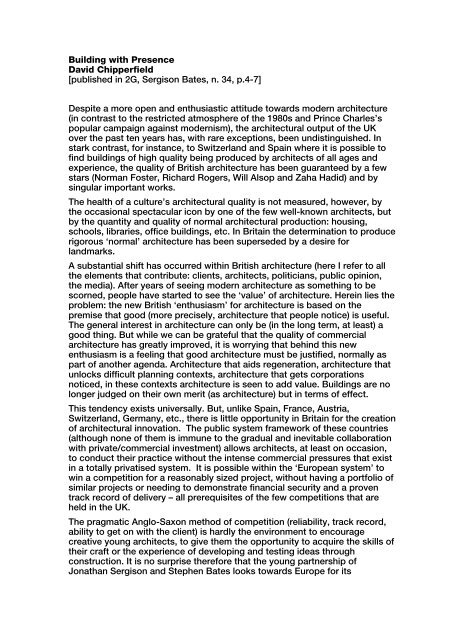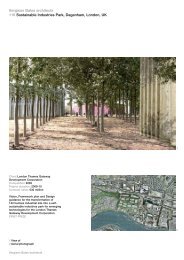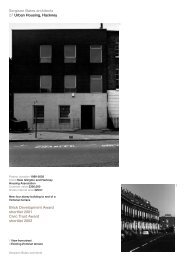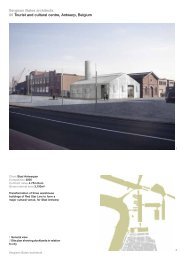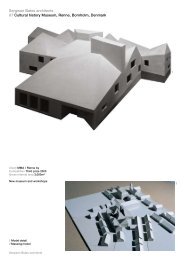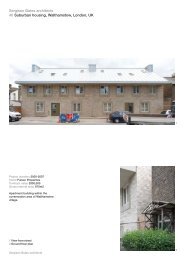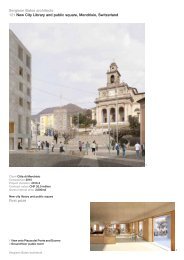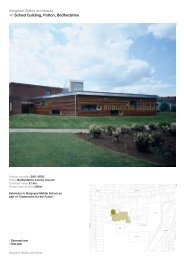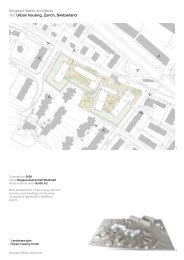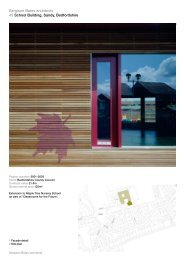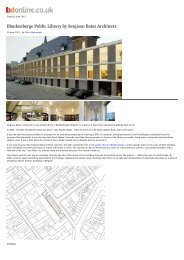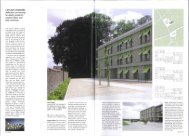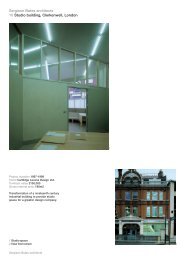David Chipperfield_Building with presence_2G intro_rev.pdf
David Chipperfield_Building with presence_2G intro_rev.pdf
David Chipperfield_Building with presence_2G intro_rev.pdf
Create successful ePaper yourself
Turn your PDF publications into a flip-book with our unique Google optimized e-Paper software.
<strong>Building</strong> <strong>with</strong> Presence<strong>David</strong> <strong>Chipperfield</strong>[published in <strong>2G</strong>, Sergison Bates, n. 34, p.4-7]Despite a more open and enthusiastic attitude towards modern architecture(in contrast to the restricted atmosphere of the 1980s and Prince Charles’spopular campaign against modernism), the architectural output of the UKover the past ten years has, <strong>with</strong> rare exceptions, been undistinguished. Instark contrast, for instance, to Switzerland and Spain where it is possible tofind buildings of high quality being produced by architects of all ages andexperience, the quality of British architecture has been guaranteed by a fewstars (Norman Foster, Richard Rogers, Will Alsop and Zaha Hadid) and bysingular important works.The health of a culture’s architectural quality is not measured, however, bythe occasional spectacular icon by one of the few well-known architects, butby the quantity and quality of normal architectural production: housing,schools, libraries, office buildings, etc. In Britain the determination to producerigorous ‘normal’ architecture has been superseded by a desire forlandmarks.A substantial shift has occurred <strong>with</strong>in British architecture (here I refer to allthe elements that contribute: clients, architects, politicians, public opinion,the media). After years of seeing modern architecture as something to bescorned, people have started to see the ‘value’ of architecture. Herein lies theproblem: the new British ‘enthusiasm’ for architecture is based on thepremise that good (more precisely, architecture that people notice) is useful.The general interest in architecture can only be (in the long term, at least) agood thing. But while we can be grateful that the quality of commercialarchitecture has greatly improved, it is worrying that behind this newenthusiasm is a feeling that good architecture must be justified, normally aspart of another agenda. Architecture that aids regeneration, architecture thatunlocks difficult planning contexts, architecture that gets corporationsnoticed, in these contexts architecture is seen to add value. <strong>Building</strong>s are nolonger judged on their own merit (as architecture) but in terms of effect.This tendency exists universally. But, unlike Spain, France, Austria,Switzerland, Germany, etc., there is little opportunity in Britain for the creationof architectural innovation. The public system framework of these countries(although none of them is immune to the gradual and inevitable collaboration<strong>with</strong> private/commercial investment) allows architects, at least on occasion,to conduct their practice <strong>with</strong>out the intense commercial pressures that existin a totally privatised system. It is possible <strong>with</strong>in the ‘European system’ towin a competition for a reasonably sized project, <strong>with</strong>out having a portfolio ofsimilar projects or needing to demonstrate financial security and a proventrack record of delivery – all prerequisites of the few competitions that areheld in the UK.The pragmatic Anglo-Saxon method of competition (reliability, track record,ability to get on <strong>with</strong> the client) is hardly the environment to encouragecreative young architects, to give them the opportunity to acquire the skills oftheir craft or the experience of developing and testing ideas throughconstruction. It is no surprise therefore that the young partnership ofJonathan Sergison and Stephen Bates looks towards Europe for its
inspiration. These are architects not interested in pursuing the spectacular,nor are they interested in concentrating their energies in the evolution ofstrategies to win commissions in the commercial market. Instead they wouldlike the opportunity to practise architecture that has social relevance andphysical meaning. They are inspired by the European architecture of the last30 years (Rafael Moneo, Álvaro Siza, Eduardo Souto de Moura, Herzog & deMeuron, Roger Diener), as well as a younger generation of Europeancontemporaries. Along <strong>with</strong> some of their London colleagues, especiallyTony Fretton and Caruso St John, they share a fascination for the work ofPeter and Alison Smithson.Visiting the office of Sergison Bates, the ambitions and values of this youngpractice are very evident. Their studio exudes the atmosphere ofconcentration and rigour: cardboard study models fill up the otherwise neatand well-organised space. Construction drawings are exhibited <strong>with</strong> greatpride. The projects that emanate from this studio are similarly rigorous andwell thought-through. The p<strong>rev</strong>ailing climate in Britain means they have nothad the opportunity to build that their European contemporaries have had.But through teaching (most recently at Zurich’s ETH), writing and a growingbody of competitions and buildings Sergison Bates have put together aconsistent body of work that quietly challenges the idea that ‘ordinary’buildings are not interesting.While others seek out glamorous foreign museums or lucrative commercialwork, Sergison Bates have focused primarily on public works: to date,particularly social housing and local regeneration projects (generally innondescript or positively run-down urban areas). In schemes like their socialhousing prototype in Stevenage or their self-build housing in Tilbury, eastLondon, they have produced intelligent answers to real social needs. Theyhave done so in ways that seek to understand and improve on existing localconditions rather than ‘importing’ external glamour (the tendency of the iconbuilders). Perhaps this has something to do <strong>with</strong> an aesthetic they share <strong>with</strong>Fretton and Caruso St John; an enjoyment of ‘realism’ and the grittiness ofurban life. Certainly in their writings Sergison Bates talk of the need for‘tolerance’ of the everyday condition of things and the need for ‘building <strong>with</strong><strong>presence</strong>’.Since setting up in practice together in the early 1990s, Sergison and Bateshave carved out a distinctive, more European-style niche in the UK. They areto be respected for their commitment to a rigorous way of working and achallenging body of work. The achievement of this young practice lies not<strong>with</strong> any singular work (though personally I am especially fond of the PublicHouse in Walsall and the mixed use development in Wandsworth), but ratherin the fact that they have accumulated both a convincing way of working andtalking about architecture and, as this monograph testifies, a body of work tobe admired. The fact that these architects are not guaranteed the position<strong>with</strong>in the ‘British system’ that they deserve and merit reflects poorly on ourarchitectural community. While they can take heart from their recentcompetition win for a library in Blankenberge, Belgium, and their growingreputation as teachers at ETH in Switzerland, it is to be hoped that they willbe able to maintain their commitment to British architecture and help todemonstrate the importance of a ‘normal’ architecture of the highest quality.


